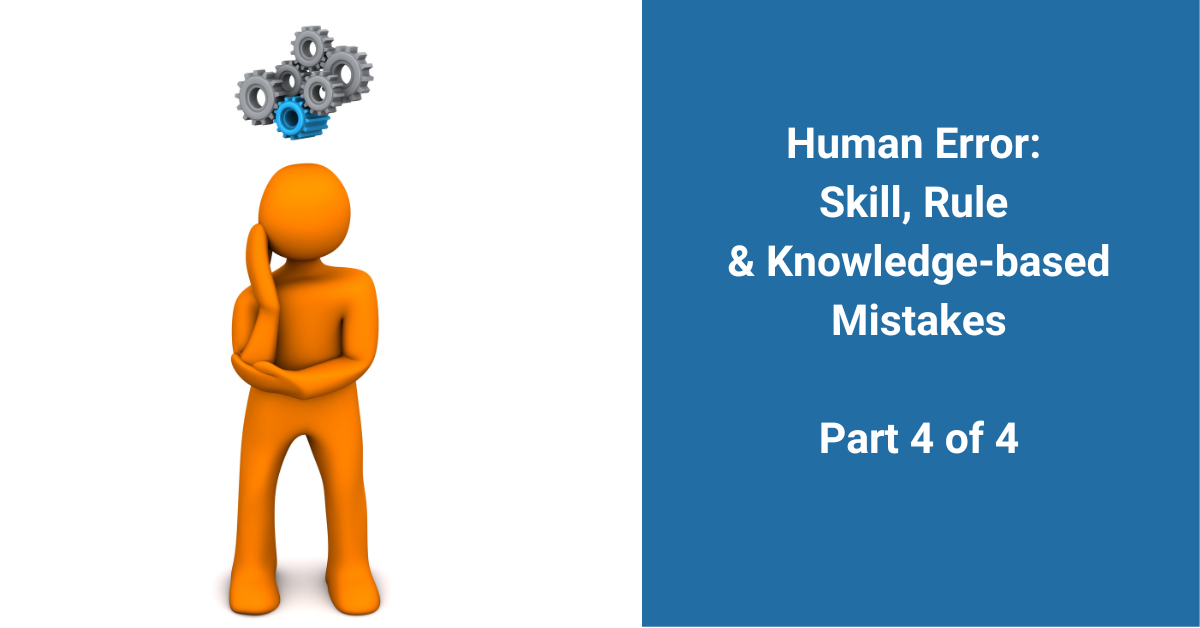Knowledge-based Mistakes

Welcome to the fourth and final installment in my series about skill, rule, and knowledge-based mistakes. This series is based on the Skills, Rules, Knowledge (SRK) Model developed by Jens Rasmussen, and the Generic Error-Modelling System (GEMS) developed by Dr. James Reason, (Part 1). I’ve also posted about skill-based errors, (Part 2), and rule-based errors, (Part 3). Today, I’m focusing on knowledge-based mistakes.
These models teach us about the capabilities and limitations of a worker’s cognitive processes. This is significant because we tend to blame workers for mistakes instead of considering his or her decisionmaking process and factors beyond the worker’s control that influenced their decisions. Learn about how you can stop human error more effectively than blaming the worker.
What are Knowledge-based Mistakes?
Workers don’t perform well in stressful, unknown situations when there are no rules, procedures, or familiar routines to guide them. Knowledge-based mistakes occur when workers in these types of situations must improvise and make up the plan as they go along. In some workplace situations, complex systems (a complicated set of controls and displays) lead to knowledge-based mistakes.

Examples of Knowledge-based Mistakes
In the simplest term, a knowledge-based mistake is when “you don’t know what you don’t know.” Workers sometimes have to fall back on problem-solving, and that takes a lot of mental resources. Knowledge-based errors happen when the problem is not analyzed correctly or not analyzed at all.
Here are a few examples:
- A work crew responds incorrectly to a plant upset that isn’t covered in the procedures.
- A technician misdiagnoses the cause of an unusual process upset and takes inappropriate action to correct it.
- A worker responds incorrectly to a multitude of alarms based on an incomplete understanding of the problem.
Are Knowledge-based Mistakes Common?
Knowledge-based mistakes occur less frequently than rule-based mistakes and skill-based errors (the biggest category of errors).
A TapRooT® Root Cause Analysis investigation will help you identify knowledge-based mistakes. The first question in the TapRooT® Root Cause Tree® Dictionary about knowledge-based decisions is: “Did a complex system require a decision by a person with little or no support from procedures or insufficient training to be able to instinctively react as required for a successful outcome?” The tool informs an investigator even if the investigator had never heard of “knowledge-based decisions.”
Incident investigators use the human factors expertise built in the TapRooT® Root Cause Tree® and the TapRooT® Root Cause Tree® Dictionary as part of an investigation process. It takes them beyond their own knowledge so they don’t make knowledge-based mistakes in their investigations!
Get to the Root Causes of Human Error
Join us for a course and learn how to get to the root cause of human error in just two days.
Thanks for joining me for this series!
I hope this series has given you some insight into the cognitive processes of human beings, and how workers can make bad decisions even though they have good intentions or believe they are being rational. Human error is not always a conscious decision, but we can improve the systems in our workplaces to safeguard against slips, lapses, rule-based mistakes, and knowledge-based mistakes.



